|
Hopton's Almshouses Hopton Street, Bankside, SE1 9JJ
|
In 1730 Charles Hopton (1654-1731), a wealthy member of the Guild of Fishmongers, bequeathed the bulk of his fortune to his sister Elizabeth, with the instruction that after her death the money was to be passed to trustees and used to build almshouses for poor single men of good character living in Southwark.
Elizabeth Hopton died in 1739 and, in 1743, the trustees purchased land near the Green Walk on which to build almshouses. The existing properties were demolished and almshouses built in their place between 1746 and 1749. The cost of the land and the buildings was around £2,700.
The buildings, consisting of 26 almshouses and a committee room, were arranged around three sides of a quadrangle containing lawns planted with shrubs and rosebushes. The site was surrounded by a brick wall.
At the first committee meeting on 10th July 1752, 26 poor elderly single men were chosen to occupy the dwellings (each almshouse consisted of an upper and a lower room). The applicants included gardeners, watermen and fishermen. Each received a stipend of not less than £6 a year, as well as 32 bushels of coal.
The almsmen were allowed to marry but, according to the rules, any children resulting from the marriage were not permitted to be chargeable to the parish.
In 1825 the almshouses were extended, when two extra houses were added to the site.
By the 19th century each almsman received a stipend of £10 a year and a chaldron of coals.
In the late 19th century the Green Walk was renamed Hopton Street.
During WW2 (1939-1945) an air-raid shelter was built in the garden. During the Blitz, in April and May 1951 four almshouses were destroyed (Nos. 1, 2, 27 and 28) and three more seriously damaged (Nos. 3, 4 and 5).
In 1988 the almshouses were rebuilt and modernised, while preserving the external appearance. The trustees provided a communal kitchen and a common room named the John Fry Room (John Fry founded the Hopton's Charity Comforts Fund in 1927 to provide aid for poor almsmen and their wives), with living accommodation above.
Since the modernisation, 20 one-bedroom almshouses have been available for men and their wives from the Southwark area.
In 2012 the residents voted to end the ban on women applying to live in the almshouses.
Current status
The Grade II* listed almshouses remain in use for housing and are owned by the United St Saviour's Charity, who took over their management from the Anchor Trust in 2011. They are now known as Hopton's Gardens.New residents are accepted from the age of 65 years. They need to have lived in Southwark for three years before application, have a low income and little capital.
N.B. Photographs obtained in December 2019
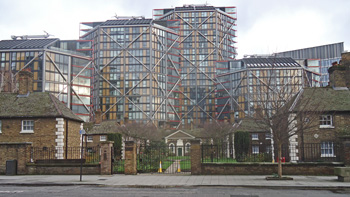
The two-storey almshouses are dwarfed by the surrounding tower blocks of NEO Bankside (above and below).
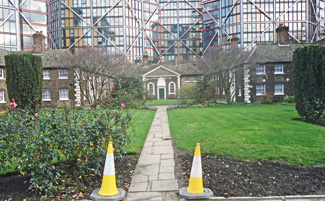

The John Fry Room provides a communal space where residents can participate in meetings and other activities.

The stone plaque above the door of the John Fry Room declares: "Chas Hopton Esq Sole Founder of this Charity Anno 1752".
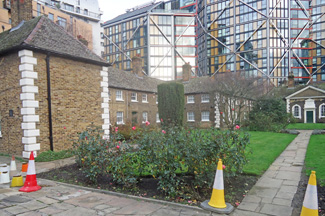
The north wing was severely damaged in 1941 and has since been rebuilt.
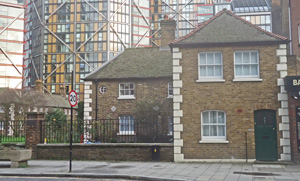
The south wing (above and below).
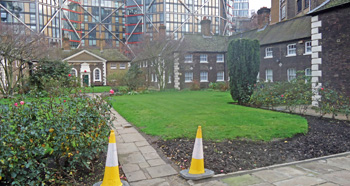

A plaque on the gatepost gives some history of the almshouses:
Hopton's Charity
Charles Hopton was born c. 1654 into a wealthy merchant family and admitted in infancy to the Guild of Fishmongers. At his death in 1731 his will provided for almshouses to be built in the parish of Christchurch, Blackfriars, for poor, single men. By 1749, 26 cottages had been completed on this land, and have been occupied continuously since July 1752. From 1988, 20 modernised cottages or flats have been available for men and their wives from the Southwark area. Donations from local benefactors ensured the survival of the original trust, created by our founder, Charles Hopton.
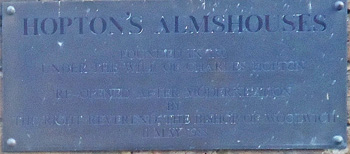
Another plaque has not worn so well:
HOPTON'S ALMSHOUSES founded in 1752 under the will of Charles Hopton re-opened after modernisation by the Right Reverend the Bishop of Woolwich in May 1988.

Signage for the Warden's House.
References (Accessed 20th October 2021)
http://alondoninheritance.com
http://bermondseyboy.net
https://britishlistedbuildings.co.uk
https://cabbieblog.com
https://charlessaumarezsmith.com
https://en.wikipedia.org
https://historicengland.org
https://housingcare.org
https://lookup.london
www.alamy.com
www.blueplaques.net
www.british-history.ac.uk (1)
www.british-history.ac.uk (2)
www.buildington.co.uk
www.flickr.com (1)
www.flickr.com (2)
www.geograph.org.uk
www.ianvisits.co.uk
www.london-se1.co.uk
www.londongardenstrust.org
www.london-se1.co.uk
www.skyeoneill.com
www.theundergroundmap.com
www.ustsc.org
Last updated 20th October 2021
Click here to return to Almshouses of London alphabetical list
Click here to return to home page